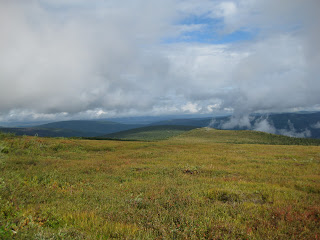We've heard that the blueberries up here are extremely plentiful. We had also heard that the blueberries were behind their normal schedule this year. As such, we were waiting to go looking for them. Last Sunday, we were talking with some friends at church about how we were going raspberry picking that afternoon because someone told us that they were on in full force and where to go find some. One of these friends, who has been here just a year or two longer than we have, mentioned that the blueberries were early this year. We looked at her funny and said we'd heard the opposite. Apparently, they had gone out and picked a bunch at the end of July.
With this news, my husband started asking around at work for recommendations on where to go find blueberries. That is no easy task around here. I did a little searching online and found
this article (published on August 1st!) that made me chuckle because it is 100% true--around here you never tell people where your berry batch is or where you go moose hunting, unless you're telling them the "known" spots. My husband actually was told a spot where there are tons of blueberries, but it was the first place mentioned in that article: Murphy Dome.
So Friday, we loaded up the family and headed out to try to find this spot on Murphy Dome. We were told that you could drive right up to it, which was good because we have two very young children and we don't yet have our bear gun up here and bears love berries even more than humans. Even so, we were armed with a bear bell (to announce your presence so you don't startle a bear), bear spray, and mosquito repellent.
The drive up to the top of the dome was fine, but we had to continue on the north side for a bit and it rained quite a bit in the previous 24 hours.
When we saw this, we decided to stop while we knew we could still turn around and get back. We weren't entirely sure what blueberry plants looked like, so we wandered off near the truck to see what we could find. What we found was a lot of blueberry plants...and very few blueberries. We thought if we wandered farther down the trail, as we were told to do, we'd find a lot more blueberries.
We found blueberries all right. However, most of what we found was completely stripped clean blueberry plants. There were blueberries all over the place, but next to no actual berries anymore.
That's all completely empty blueberries.
So are those. We walked all the way out to the rocky outcropping in the distance. Obviously, we were a few weeks too late.
My husband and our daughter wandered all over out there thinking there HAD to be some out there still. Yeah, they were wrong. We saw many lingonberries (also called low-bush cranberries) and other berries that we didn't know whether they were edible or not. We picked what few blueberries we found as we headed back toward our truck. As we were on our way back up the trail, we met a family who was out for crowberries and bearberries, two varieties of black berries that we'd seen plenty of but didn't know were edible. Once we learned that, we tried some and started picking those as well.
 |
| Picking blueberries |
 |
| Picking bearberries |
We didn't come home with a huge haul, but, after doing research on crowberries and bearberries, we determined we would go back out and get more crowberries another day. But that is a story for another day.
 |
| Mostly crowberries on the left and blueberries on the right. |
Even though that's all we came home with from an afternoon of picking, we had a great time hiking and the scenery was amazing.
 |
| Heading back into town |
























































